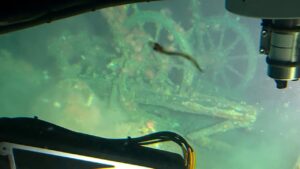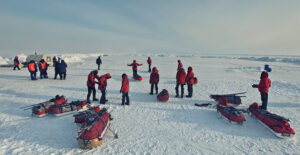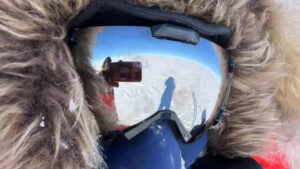The pressure of millions of tons of moving ice was crushing and smashing inexorably.
(Correne Coetzer) “Mighty blocks of ice, gripped between meeting floes, rose slowly till they jumped like cherry-stones squeezed between thumb and finger. The pressure of millions of tons of moving ice was crushing and smashing inexorably. If the ship was once gripped firmly her fate would be sealed.”
Trapped in the Antarctic ice, August 1915, Shackleton and his men commemorated a year since they had left England on Endurance to Antarctica, experiencing the pressure of millions of tons of moving ice.
First days of August
On August 1, at position 72° 26´ S, long. 048° 10´ W, the break-up in their floe came suddenly, Ernst Shackleton wrote in his book, South.
“I had the dogs and sledges brought aboard at once and the gangway hoisted. The animals behaved well. They came aboard eagerly as though realizing their danger, and were placed in their quarters on deck without a single fight occurring. The pressure was cracking the floe rapidly, rafting it close to the slip and forcing masses of ice beneath the keel. Presently the Endurance listed heavily to port against the gale, and at the same time was forced ahead, astern, and sideways several times by the grinding floes.””
Shackleton had the boats cleared away ready for lowering, got up some additional stores, and set a double watch. All hands were warned to stand by, get what sleep they could, and have their warmest clothing at hand, he wrote.
“Around us lay the ruins of “Dog Town” amid the debris of pressure-ridges. Some of the little dwellings had been crushed flat beneath blocks of ice; others had been swallowed and pulverized when the ice opened beneath them and closed again. It was a sad sight, but my chief concern just then was the safety of the rudder, which was being attacked viciously by the ice.”
Although Shackleton was impressed with Endurance that withstood the attacks of the ice, but the rudder had been driven hard over to starboard and the blade partially torn away from the rudder-head. Heavy masses of ice were still jammed against the stern, and it was impossible to ascertain the extent of the damage at that time, he revealed.
Drift and soundings
They drifted north and northwest with nine hours of twilight, with good light at noon. There was no land in sight for ten miles from the mast-head. The pack as far as the eye could reach was in a condition of chaos, much rafted and consolidated, with very large pressure-ridges in all directions.
“We had bad luck with soundings, the weather interfering at times and the gear breaking on several occasions, but a big increase in the depth showed that we had passed over the edge of the Weddell Sea plateau. A sounding of about 1700 fathoms on August 10 agreed fairly well with Filchner’s 1924 fathoms, 130 miles east of our then position,” noted Shackleton.
“A sounding of 1900 fathoms on August 25 was further evidence of the non-existence of New South Greenland,” he added.
Icebergs
On clear days they could get an extended view in all directions from the mast-head, and the line of the pack was broken only by familiar bergs. “About one hundred bergs were in view on a fine day, and they seemed practically the same as when they started their drift with us nearly seven months earlier. The scientists wished to inspect some of the neighbouring bergs at close quarters, but sledge travelling outside the well-trodden area immediately around the ship proved difficult and occasionally dangerous. On August 20, for example, Worsley, Hurley, and Greenstreet started off for the Rampart Berg and got on to a lead of young ice that undulated perilously beneath their feet. A quick turn saved them.”
“The distant pack is thrown up into towering barrier-like cliffs, which are reflected in blue lakes and lanes of water at their base. Great white and golden cities of Oriental appearance at close intervals along these clifftops indicate distant bergs, some not previously known to us. Floating above these are wavering violet and creamy lines of still more remote bergs and pack. The lines rise and fall, tremble, dissipate, and reappear in an endless transformation scene.”
“The southern pack and bergs, catching the sun’s rays, are golden, but to the north the ice-masses are purple. Here the bergs assume changing forms, first a castle, then a balloon just clear of the horizon, that changes swiftly into an immense mushroom, a mosque, or a cathedral. The principal characteristic is the vertical lengthening of the object, a small pressure-ridge being given the appearance of a line of battlements or towering cliffs. The mirage is produced by refraction and is intensified by the columns of comparatively warm air rising from several cracks and leads that have opened eight to twenty miles away north and south.”
Dogs and Penguins
All hands and the carpenter made kennels on the upper deck. The training of the dogs, including the puppies, proceeded actively, and provided exercise as well as occupation.
They captured a few emperor penguins which were making their way to the south-west. Ten penguins taken were all in poor condition, and their stomachs contained nothing but stones and a few cuttle-fish beaks.
August 31st
The end of the month the ice crashing and smashing started again. “Late on the night of the 31st the ice began to work ahead of the ship and along the port side. Creaking and groaning of timbers, accompanied by loud snapping sounds fore and aft, told their story of strain,” Shackleton wrote.
The pressure continued during the following day, beams and deck planks occasionally buckling to the strain. The ponderous floes were grinding against each other under the influence of wind and current, and our ship seemed to occupy for the time being an undesirable position near the centre of the disturbance; but she resisted staunchly and showed no sign of water in the bilges, although she had not been pumped out for six months.”
“The pack extended to the horizon in every direction. I calculated that we were 250 miles from the nearest known land to the westward, and more than 500 miles from the nearest outpost of civilization, Wilhelmina Bay. I hoped we would not have to undertake a march across the moving ice-fields. The Endurance we knew to be stout and true; but no ship ever built by man could live if taken fairly in the grip of the floes and prevented from rising to the surface of the grinding ice.”
September 2nd, 1915
These were anxious days, Shackleton stated. “In the early morning of September 2 the ship jumped and shook to the accompaniment of cracks and groans, and some of the men who had been in the berths hurried on deck.” u2028u2028
“The pressure eased a little later in the day, when the ice on the port side broke away from the ship to just abaft the main rigging. The Endurance was still held aft and at the rudder, and a large mass of ice could be seen adhering to the port bow, rising to within three feet of the surface. I wondered if this ice had got its grip by piercing the sheathing.”
Background:
On August 8, 1914, Ernest Shackleton and his crew set off from Plymouth, England, on the Endurance for the 1914-17 Imperial Trans-Antarctica Expedition. This became one of the most heroic, endurance and leadership adventure stories in history.
The Endurance, the ship which will take the Trans-continental party to the Weddell Sea, and will afterwards explore along an unknown coast-line, is a new vessel, specially constructed for Polar work under the supervision of a committee of Polar explorers. She was built by Christensen, the famous Norwegian constructor of sealing vessels, at Sandefjord. She is barquentine rigged, and has triple-expansion engines giving her a speed under steam of nine to ten knots. To enable her to stay longer at sea, she will carry oil fuel as well as coal. She is of about 350 tons, and built of selected pine, oak, and greenheart. This fine vessel, equipped, has cost the Expedition £14,000.
#polar #shackleton #endurance
#southpole #antarctica






